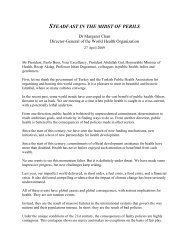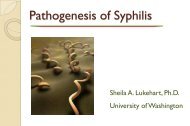The Evolution of HTA in Emerging Markets Health-Care ... - TREE
The Evolution of HTA in Emerging Markets Health-Care ... - TREE
The Evolution of HTA in Emerging Markets Health-Care ... - TREE
You also want an ePaper? Increase the reach of your titles
YUMPU automatically turns print PDFs into web optimized ePapers that Google loves.
OHE Consult<strong>in</strong>g Report for PhRMA<br />
5 January 2011<br />
<strong>The</strong> NDRC operates two primary drug pric<strong>in</strong>g regulations: (1) uniform price ceil<strong>in</strong>gs applicable to<br />
generics satisfy<strong>in</strong>g GMP standards, and (2) ‘<strong>in</strong>dependent pric<strong>in</strong>g’ for imported Western branded<br />
products, mostly patented medic<strong>in</strong>es, <strong>of</strong>f-‐patent orig<strong>in</strong>ators, and follow-‐on generics <strong>of</strong> superior<br />
quality (presumably <strong>in</strong> terms <strong>of</strong> convenience <strong>in</strong> dos<strong>in</strong>g schedules and adm<strong>in</strong>istration). In theory this<br />
can <strong>in</strong>clude Ch<strong>in</strong>ese manufacturers, but most Ch<strong>in</strong>ese manufacturers are produc<strong>in</strong>g generic drugs.<br />
This ‘<strong>in</strong>dependent pric<strong>in</strong>g’ policy enables ‘superior’ drug products (<strong>in</strong> terms <strong>of</strong> safety and efficacy) to<br />
get higher prices.<br />
<strong>The</strong> NDRC has also <strong>in</strong> place mandatory retail price cuts for ‘older’ drugs (the size <strong>of</strong> price cuts<br />
averag<strong>in</strong>g around 20%). <strong>The</strong>se mandatory price cuts failed to control pharmaceutical expenditures<br />
s<strong>in</strong>ce less attention was given to rational use <strong>of</strong> medic<strong>in</strong>es (with many hospitals and doctors hav<strong>in</strong>g<br />
an <strong>in</strong>centive to overprescribe) and some domestic drug producers responded to these mandatory<br />
price cuts for ‘older’ drugs by launch<strong>in</strong>g ‘new’ drugs which were branded generic versions <strong>of</strong> the old<br />
drugs with a new name, formulation and packag<strong>in</strong>g. However, the effect has been to squeeze the<br />
local Ch<strong>in</strong>ese generics drug <strong>in</strong>dustry. Experts suggest this reflects a policy objective <strong>of</strong> try<strong>in</strong>g to<br />
reduce the number <strong>of</strong> suppliers to get rid <strong>of</strong> the less efficient ones and so reduce prices.<br />
<strong>The</strong>re has been a recent reform <strong>of</strong> the Essential Drug List (EDL) by the MoH (<strong>in</strong> terms <strong>of</strong> which drugs<br />
are <strong>in</strong>cluded). <strong>The</strong> MoH is us<strong>in</strong>g the EDL to try to reduce costs <strong>in</strong> public hospitals, which would have<br />
to use the EDL. It has had the effect <strong>of</strong> reduc<strong>in</strong>g the potential for hospitals to <strong>in</strong>crease the revenues<br />
from the 15% mark up by us<strong>in</strong>g higher priced drugs and replac<strong>in</strong>g local purchas<strong>in</strong>g with a regional<br />
procurement exercise to get suppliers for the EDL list. It is not at all clear how much evidence has<br />
been used to generate the EDL. It seems the EDL was comprised mostly by committees <strong>of</strong> op<strong>in</strong>ion<br />
leader doctors list<strong>in</strong>g what they like to prescribe.<br />
<strong>The</strong> EDL is made up <strong>of</strong> two lists A and B. List A <strong>in</strong>cludes all drugs considered ‘cl<strong>in</strong>ically necessary,<br />
widely used, safe and efficacious; and price advantageous among its class’. EDL A is the national drug<br />
list and cannot be modified by local governments. EDL B is similar except that the prices <strong>of</strong> products<br />
listed tend to be higher than similar products listed on EDL A. Local governments are only allowed to<br />
modify the national EDL by add<strong>in</strong>g up to 15% to the number <strong>of</strong> drugs listed <strong>in</strong> EDL A. Although it is<br />
stated that cost-‐effectiveness is not a criteria for the selection <strong>of</strong> EDL drugs, recent revisions <strong>of</strong> EDL<br />
guidel<strong>in</strong>es explicitly ask for the <strong>in</strong>volvement <strong>of</strong> health-‐economists <strong>in</strong> the determ<strong>in</strong>ation <strong>of</strong> the EDL.<br />
Some foreign drug companies already have been voluntarily submitt<strong>in</strong>g pharmacoeconomic data<br />
along with their conventional submissions for list<strong>in</strong>g on the EDL. However, as we noted earlier, it is<br />
not clear how evidence-‐based EDL list<strong>in</strong>g decisions are.<br />
<strong>The</strong> MoHRSS is now try<strong>in</strong>g to <strong>in</strong>troduce pric<strong>in</strong>g rules for the reimbursement prices it pays for the two<br />
<strong>in</strong>surance schemes (UEBMI and URBMI) for which it is responsible. It is not clear how this works <strong>in</strong><br />
relation to the NDRC, but if NDRC sets the maximum price (or the drug qualifies for <strong>in</strong>dependent<br />
pric<strong>in</strong>g) then MoHRSS as the payer can decide on what k<strong>in</strong>d <strong>of</strong> drugs it will reimburse and at what<br />
rate, rather than the maximum price. In this selection process, it may plan to use <strong>HTA</strong> pr<strong>in</strong>ciples, but<br />
the drug cap itself is set by NDRC rather than MoHRSS. <strong>The</strong> NDRC, like other government bodies,<br />
recognise that use <strong>of</strong> pharmacoeconomics might be beneficial <strong>in</strong> the price sett<strong>in</strong>g process, but no<br />
<strong>of</strong>ficial guidel<strong>in</strong>es have been put forward <strong>in</strong> practice. As the <strong>in</strong>dependent pric<strong>in</strong>g arrangement is<br />
reserved <strong>in</strong>clud<strong>in</strong>g an “<strong>in</strong>novative category” which covers the majority <strong>of</strong> imported Western<br />
patented drugs. NDRC does not set the prices for these products, although it does set the prices <strong>of</strong><br />
generic named versions, and <strong>in</strong>novators are allowed a percentage mark up above that price.<br />
90








